


|
Jeffrey Catherine Jones died today - 5/19/2011 a tragic and unfathomable loss. |
||
 |
  |
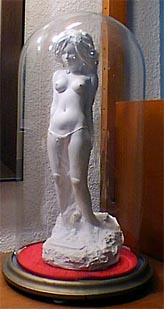 |
| The Burroughs Bulletin #16 - 1966 | Boris Karloff Tales of Mystery #21 - March 1968 | Statue #1 - 1970 |
|
Everybody starts somewhere. Jeff Jones started in Atlanta Georgia
in 1944. He wanted to be a scientist when he grew up and even
studied Geology in college. However, in the winter of 1967 when
he moved to New York it was in search of work as an artist. He
found a little work as an artist in comic books and fanzines
- neither of which paid enough to adequately support him and
his wife and child. But those early stories in long-forgotten
comics from Gold Key and King, for the new black and white horror
magazines, Creepy and Eerie, from Warren, and the
b&w story illustrations for the science fiction digests,
Amazing and Fantastic, led to more lucrative work
in the burgeoning paperback cover market. He also landed a book
illustration job that year, doing the dust jacket and frontispiece
for I Am A Barbarian, the first printing of an unpublished
novel by Edgar Rice Burroughs. |
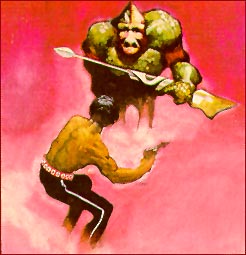 City of the Chasch - Jack Vance 1968 |
|
Frank Frazetta's
Conan covers had hacked their way into the public consciousness
in 1966 and 1967 and the art directors had their goal: find people
who could paint like Frazetta. It's obvious that Jones' early
sf work owes much to Mr. Frazetta, but it's a very serious mistake
to relegate all of his early work to the sf and fantasy categories.
The painting for City of the Chasch, above right, is one of his very early attempts, but that first year, 1968, saw his work on literally dozens of books of all genres. Just take a look at the sampling at right, all from 1968. From series adventure books like Nick Carter's Amsterdam to Pulitzer Prize winning titles like Ellen Glascow's In this Our Life to romantic adventure, gothic romance, sexy black comedies and more, Jones was all over the newstands that first year. I was 22 in 1968 and had so incredibly much more time that I was able to make a weekly (sometimes twice weekly) trip to a local book store to walk up and down the aisles looking for new Jones covers. I'd seen his work in the sf section and thought I'd check out the rest of the store. Kepler's Books (it's still around today and surviving in the face of the monolithic chains) had the wonderful practice of displaying the newly arrived books with their covers face out while prior weeks' material was visible only from the spine. By coming in every week, I was able to discover these and many other obscure Jones covers. I'm sure someone else would have (and may have) found them, too, but every list of his work to which I contributed was missing a dozen or more of these non-sf titles. Jones illustrated his second book that year, doing four color plates for Red Shadows - a collection of Solomon Kane stories by Robert E. Howard. But back to my point: Jones was never a Frazetta clone. I'm sure he got some assignments because he was able to provide a passable version of the style, but one look at A Woman of Bangkok at right and it is obvious that he had a style and a talent very early on that had nothing to do with muscular barbarians. He provided over 150 covers for many different types of books through 1976. |
 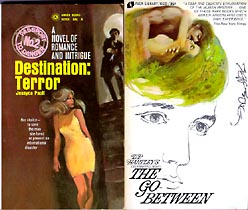   |
| The final spate of Jones cover art was for a re-release of Robert E. Howard material. By this point there was a mannered, painterly, almost N.C. Wyeth feel to his art. I'll show you some, but first a little detour to Idyl and The Studio. | |
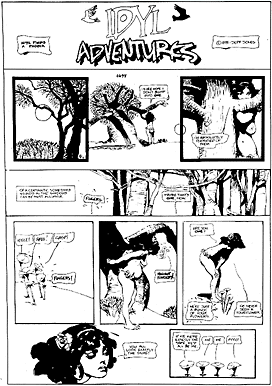
|
Jones always contributed to many different markets. He created a sculpture (see above) that he cast and had to re-cast, as many that were sent to buyers through the mail arrived in pieces. (Mine was one of the fortunate ones). He was still providing elegant illustrations to Amazing Stories and Fantastic, the sf pulp digest, in 1972. That same year he had an illustration in Esquire magazine and a painting in the first issue of Gallery as well. He had a two-page strip that ran in Swank magazine for seven months, stories and covers in Psycho (a Creepy competitor), covers for some DC comic books, and in January of that year he began a long-running page in National Lampoon called Idyl. It was originally intended to be painted and in color, but the effort was too much and only one partially completed example exists. But of the b&w version, every issue of NatLamp from Jan. 1972 to Aug. 1975 had one page of his delicious pen work and his outrageously wry humor. If Seinfeld was the TV show about nothing, Idyl was the comic strip. At left is one of the two pages that appeared in the special 3-D issue (the one with Stevie Wonder on the cover) in July 1975. |

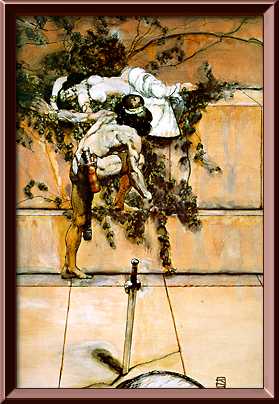
![]() In
1976, Jones gave up commercial art. Idyl and other
work had been created away from New York City, in Woodstock. He
returned to New York in 1975, but not for the art directors and
the assignments. He returned to feed the artist that lurked within,
the one that the art directors could never really touch. With
Bernie Wrightson, Barry Windsor-Smith and Michael Kaluta, Jones formed The Studio.
This 2000 square foot loft was shared by the four artists, but
the hoped-for synergy seldom happened. Jones explored his muse
in the early dawn hours, creating images that were marketed as
posters and signed prints. Most famous is Blind Narcissus,
the mamoth 8'x4' canvas of a wistful woman in a Waterhouse woods.While
Windsor-Smith was creating his Pre-Raphaelite paeans, Jones was
exploring the influences of James McNeill Whistler, John W. Waterhouse
and other late 19th Century romantics.
In
1976, Jones gave up commercial art. Idyl and other
work had been created away from New York City, in Woodstock. He
returned to New York in 1975, but not for the art directors and
the assignments. He returned to feed the artist that lurked within,
the one that the art directors could never really touch. With
Bernie Wrightson, Barry Windsor-Smith and Michael Kaluta, Jones formed The Studio.
This 2000 square foot loft was shared by the four artists, but
the hoped-for synergy seldom happened. Jones explored his muse
in the early dawn hours, creating images that were marketed as
posters and signed prints. Most famous is Blind Narcissus,
the mamoth 8'x4' canvas of a wistful woman in a Waterhouse woods.While
Windsor-Smith was creating his Pre-Raphaelite paeans, Jones was
exploring the influences of James McNeill Whistler, John W. Waterhouse
and other late 19th Century romantics.
While the foreground of Sleep (at left) tosses a phallic bone to the sword and sorcery crowd, the languid pose and weathered marble could be right out of an Alma-Tadema opus. Images such as The Wall and In A Sheltered Corner, also from the Studio era, were equally impressive. On the latter print, Jones remarqued a blood red leaf on each print he signed. A most interesting phenomenon happened in 1978 when he illustrated a new edition of Red Shadows for publisher Donald M. Grant. It's not often that we get to see an artist approach the same subject matter twice. This era was culminated by the publication of The Studio, a sumptuous 12"x12" art book devoted to the four artists, from Dragons Dream in 1979.
1980 saw the release, also from Dragon's Dream, of Yesterday's Lily, the first book devoted solely to Jones. To date, it's still the book that provides the best overall view of his work. Many paintings for paperback covers and dust jackets are shown here sans text and in large format. Another excellent book is Underwood Books' Age of Innocence from 1994. This is devoted to his most romantic work and is now out of print, too.
 The
best reproduction of his pencil drawings is found in The Drawings
of Jeffrey Jones (1982 Cygnus). It's a boxed portfolio of
eight perfectly reproduced pencil drawings (see image at right).
It's also signed and numbered and limited to 750 copies, which
makes it both difficult to find and quite dear when one does.
Very little of his work was commercial during the last 30 years
and prints and portfolios were the main channel of image-to-customer.
As a Child (1980) and World Without End (1980) are
two excellent samples. He also did individual plates for multi-artist
portfolios like Night (1985) and The Edgar Rice Burroughs
Portfolio (1974). The Catskill Witch is a book from
1974 with Jones b&w plates.
The
best reproduction of his pencil drawings is found in The Drawings
of Jeffrey Jones (1982 Cygnus). It's a boxed portfolio of
eight perfectly reproduced pencil drawings (see image at right).
It's also signed and numbered and limited to 750 copies, which
makes it both difficult to find and quite dear when one does.
Very little of his work was commercial during the last 30 years
and prints and portfolios were the main channel of image-to-customer.
As a Child (1980) and World Without End (1980) are
two excellent samples. He also did individual plates for multi-artist
portfolios like Night (1985) and The Edgar Rice Burroughs
Portfolio (1974). The Catskill Witch is a book from
1974 with Jones b&w plates.
 I
promised earlier to get back to his style of the mid 70's. One
of the commercial assignments he accepted was the illustrations
for a 1977 hardcover edition of Thomas Burnett Swann's Queens
Walk in the Dusk. At left is one of the nine plates from the
book and explains a lot better than my words just how his illustrative
style was changing.
I
promised earlier to get back to his style of the mid 70's. One
of the commercial assignments he accepted was the illustrations
for a 1977 hardcover edition of Thomas Burnett Swann's Queens
Walk in the Dusk. At left is one of the nine plates from the
book and explains a lot better than my words just how his illustrative
style was changing.
In 1993, with the release of a set of art trading cards, Jones captured a second generation of fans. A follow-up set and the publication of Age of Innocence set him solidly back in the public eye. A 1998 Tarzan Calendar marked his first commercial job for some many years. One of the images, Tarzan Rescues the Moon (below left), won the Gold Medal in Spectrum Five's juried competition. Jones did the dustjacket and two color plates for the deluxe edition of The Game of Thrones in 2000, from Meisha-Merlin Press. Sadly, the many black and white line drawings therein were marred by low-resolution scans. Glimmer Graphics produced a limited edition print of the dustjacket. I hope Todd won't mind that I reproduce it below, right.
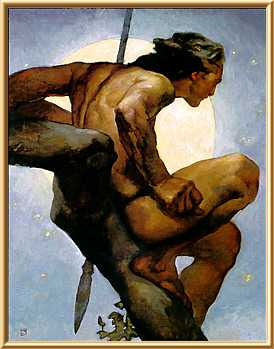
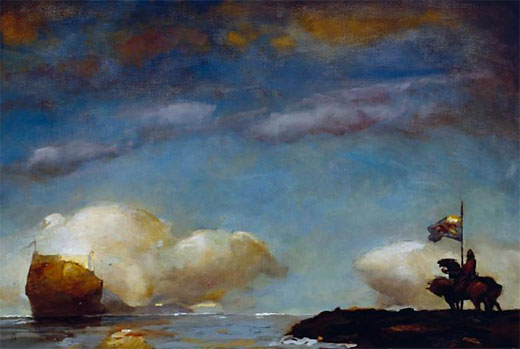
Since he left the studio in New York, Jones has lived in Woodstock, NY. In 1995 we saw some of his pleine air paintings which he was kind enough to show us at San Diego. I hope somewhere out there is a publisher with the courage to produce a book devoted to this type of work. These small paintings, mainly landscapes done outdoors, are precious jewels that shouldn't be hidden away. They're one more side of a multi-faceted talent. One of our favorites.
Feb. 20, 2011 - a post from Todd Adams
of GlimmerGraphics:
www.glimmergraphicsprints.com |
 To learn more about Jeffrey Jones, see:
To learn more about Jeffrey Jones, see:
| The Studio | 1979 Dragon's Dream |
| Yesterday's Lily | 1980 Dragon's Dream |
| Age of Innocence - The Romantic Art of Jeffrey Jones | Arnie Fenner & Cathy Burnett, 1994 Underwood |
| The Art of Jeffrey Jones | Cathy & Arnie Fenner, 2002 Underwood |
| Jeffrey Jones: A Life in Art | Cliff Biggers and Jeffery Jones, 2010 Desperado |
| Jeff Jones – une biographie et une bibliographie | Jacques Dutrey, 2011 |
| The Vadeboncoeur Collection of Knowledge | Jim Vadeboncoeur, Jr. 1998 |
|
Illustrations are copyright by their
respective owners. This page written, designed & © 1998 by Jim Vadeboncoeur, Jr. Updated 2011. |
